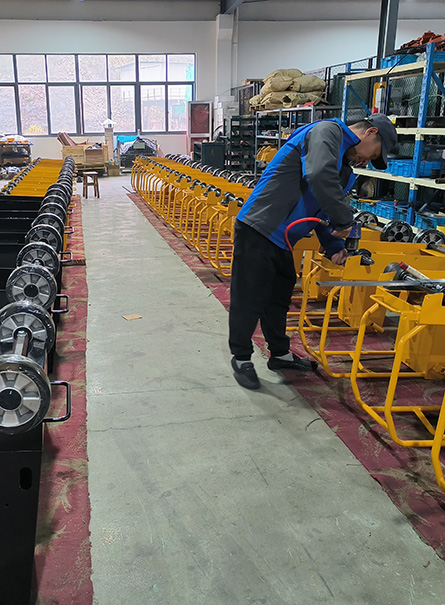Tamping rammers, unique machines designed for compressing assorted kinds of earth in diverse building scenarios, impact the soil surface, achieving evenness and denseness.
The vibratory tamping rammer, a nimble and movable soil-compressing device, utilizes vibration for compaction.
Understanding the Tamping Rammer
Mechanism of Action
The vibratory tamping rammer, celebrated for its portability and lightness, compacts soil through vibration. Its rounded silhouette and straightforward usage enable it to access cramped spaces, making it a champion in hard-to-reach zones. These units are energized by gasoline, diesel, or electric motors.
Tamping rammers concentrate on specific areas with direct compaction, unlike vibrating the soil in place. Their sleek form allows them to infiltrate spots inaccessible to vibrating plate compactors.
Ideal Soil for Tamping Rammer
These rammers compact the earth by direct impact, exerting substantial compressive force, squeezing out air and moisture.
Tamping rammers, also termed jump jacks or jack rammers, are effective in soils with moisture levels as low as 13%. They shine with cohesive soils like clay or high-clay-content soils, which cling tightly, especially when wet. These soils are challenging to fracture when dry and don't crumble.
Avoid using a rammer on gravel or asphalt to prevent equipment damage. Also, rammers aren't suitable for granular materials, as they may just create holes in such terrain.
Diverse Rammer Styles
Gasoline-Powered Tamping Rammer
This type operates on a two-stroke internal combustion engine principle, featuring dual pistons (upper combustion piston and lower buffer piston). The cylinder, with its inclined bottom-surface rammer, leans forward.
The upper piston rod juts out from the cylinder head cover's center, while the lower rod extends from the cylinder's base, merging with the rammer. The cylinder and rammer are spring-tensioned, with handrails for control.
Motorized Tamping Rammer
Based on rotational inertia force, it comprises a rammer, frame, eccentric block, pulley, and motor.
The motor and gearbox nest on the skid base, with the ram frame's rear end pivoting on the transmission shaft. The ram frame oscillates due to the eccentric block's centrifugal force.
Tamping Rammer Applications
In the Construction Realm
Rammers are versatile for:
- Building foundations
- Asphalt pavements
- Courtyards
- Bridge piles
- Narrow sites, among other settings
In Agriculture
- Fields
- Troughs
In Mining
- Trenches
- Compacting trench bases
Selecting the Right Rammer
- Size and Portability
Smaller, lighter rammers are more transportable. A travel dolly is a bonus, bridging the gap between the truck parking and the compaction site. Maneuvering a rammer to a trench through soil isn't trivial. A travel dolly can be a game-changer, reducing manpower and hastening transportation.
- Engine Variants
Motor-powered rammers are quieter but tethered by cables. Diesel-powered versions are louder but offer freedom from cords.
Hearing protection is crucial, especially with loud equipment like rammers. Preventing auditory damage from the outset is key.
- Impact Strength
The impact force is crucial, particularly for clayey sands requiring heavier rammers.
- Adjustable Handle
Using equipment not tailored to your stature can be challenging. Tamping rammers with adjustable handles allow customization for comfortable operation, accommodating varying user heights.
- Maintenance and Safety
Regular Upkeep
Perform routine visual checks.
Ensure fuel and engine oil levels are optimal, checking for leaks or cracks in lines and fittings.
Secure all external and ramming shoe hardware.
Maintain a clean air cleaner cover.
Use an air compressor for engine cooling fin cleaning.
Inspect and adjust the spark plug gap.
Replace filters as needed.
Clean the recoil starter.
Change ramming system oil.
Maintain the engine muffler and exhaust port.
Inspect the lifting cable for wear or damage.
Check the fuel filter.
Examine and repair any damaged fuel and oil lines, replacing them biennially regardless of visible wear.
Safety Precautions
Wear protective eyewear, hearing protection, and safety shoes.
Keep hands, feet, and loose clothing clear of moving parts.
Exercise caution and common sense when operating a rammer.
Ensure the rammer is stable and secure when not in use.
Conclusion
Tamping rammers are indispensable in compressing various types of earth across multiple construction environments. They uniquely impact the soil surface, ensuring levelness and compaction.
These rammers, favoring direct compaction, emphasize specific spots. They excel with cohesive soils, ensuring a tightly packed foundation for various construction projects.


